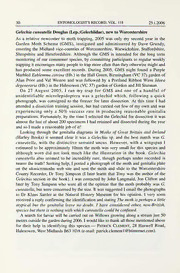
Gelechia cuneatella Douglas (Lep.: Gelechiidae), new to Worcestershire PDF
Preview Gelechia cuneatella Douglas (Lep.: Gelechiidae), new to Worcestershire
30 ENTOMOLOGIST'SRECORD,VOL. 118 25.L2006 Gelechiacuneatella Douglas(Lep.:Gelechiidae),newtoWorcestershire As a relative newcomer to moth trapping, 2005 was only my second year in the Garden Moth Scheme (GMS), instigated and administered by Dave Grundy, covering the Midland vice-counties ofWorcestershire, Warwickshire, Staffordshire, Shropshire and Herefordshire. Although the GMS is intended for the long term monitoring ofour commoner species, by committing participants to regular weekly trapping itencouragesmanypeopletotrap moreoftenthanthey otherwisemightand has produced some excellent records. During 2005, GMS night found a Purple Marbled Eublemma ostrina (Hb.) in the Hall Green, Birmingham (VC 37) garden of Alan Prior and Val Weston and was followed by a Portland Ribbon Wave Idaea degeneraria (Hb.) inthe Halesowen (VC 37) gardenofGordonandJill Sturman. On 27 August 2005, I ran my trap for GMS and one of a handful of unidentifiable microlepidoptera was a gelechid which, following a quick photograph, was consigned to the freezer for later dissection. At this time I had attended a dissection training session, but had carried out few ofmy own and was experiencing only a 50% success rate in producing reasonable genitalia preparations. Fortunately, by the time I selected the Gelechid for dissection it was almost the last ofabout 200 specimens I had retained and dissected during the year and so I made areasonablejob ofit! Looking through the genitalia diagrams in Moths ofGreat Britain and Ireland (Harley Books) it seemed clear it was a Gelechia sp. and the best match was G. cuneatella, with the distinctive serrated uncus. However, with a wingspan I estimated to be approximately 10mm the moth was very small for this species and although worn did not look much like the illustration in the book. Gelechia cuneatella also seemed to be incredibly rare, though perhaps under recorded is nearer the truth? Seeking help, I posted a photograph ofthe moth and genitalia plate on the ukmicromoths web site and sent the moth and slide to the Worcestershire County Recorder, Dr Tony Simpson (I later learnt that Tony was the author of the Gelechia section in the book). I was contacted by John Langmaid, Jon Clifton and later by Tony Simpson who were all of the opinion that the moth probably was G. cuneatella, but were concernedby the size. It was suggested I email the photographs to Dr Klaus Sattler at the Natural History Museum for his opinion. I very soon received areply confirming the identification and stating Themoth isperhapsa little atypical hut the genitalia leave no doubt. / have considered other, non-British, speciesbutthere isnothingwith whichcuneatella couldbeconfused. A search for larvae will be carried out on Willows growing along a streamjust 50 metresoutsidethegardenduring2006. 1wou—ldliketothankallthosementionedabove for their help in identifying this species. Patrick Clement, 28 Haswell Road, Halesowen,WestMidlandsB63 IDA(e-mail: [email protected]).
